Changing “Art” Institutions for Art Experiences
By Amrit
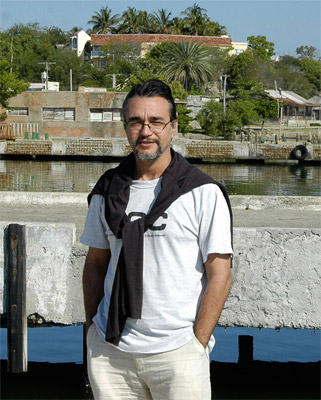
HAVANA TIMES, Oct. 2 — It was back in the ‘90s, in a passageway in Old Havana, where I first met visual artist Angel Alonso. He was among a group of painters and artisans trying to sell their works. I myself was selling some clay necklaces, and when I crossed the cobblestone street I recall catching people’s attention because of the clicking of my high heels. From this I remember his smile from among an amalgam of faces that have long since faded into oblivion. A few weeks ago we ran into each other in Fraternity Park and I proposed interviewing this engaging character for Havana Times.
Since it turned out to be too difficult for me to pin down a time and place to meet, he agreed to respond to my questions by e-mail.
HT: Tell me about your childhood, your family environment.
Angel Alonso: My childhood went by in a flurry of motion and activity, relocating from house to house and changing schools; my parents were always moving with the aim of finally becoming independent from the rest of the family. It was a supportive environment and I received lots of affection, but the changes in schools — with me always being the new kid — created some problems for me. By the time I arrived, the others had already formed into groups of friends and I felt like the lone cowboy from the movies, when he drifts into a new town and asks for a glass of milk at the bar. Then, as soon as I’d start identifying with a neighborhood or with a group of students, I had to leave again. This became a pattern that repeated itself all my life.
HT: When and how did your encounter with art occur?
AA: I think my encounter with art was natural. All children like to draw or make play-doh figures. What happens is that later, when they grow up, they become involved in other things. I just decided to continue, so after elementary school I registered at the provincial School of Visual Arts on 23rd and C streets. Subsequently I continued at San Alejandro and graduated from there.
HT: When I met you in that passageway in Old Havana it was during the years of the Special Period crisis, a situation which did so much to transform practical life, ideology and the hopes of Cubans. Your painting back then was an expression of that convulsion, that general sense of loss, with those rafts that launched into the abyss of the sea seeking escape?
AA: My painting arose precisely from that convulsion, because prior to that I had actually been developing non-pictorial work starting in the ‘80s. I had been working with installations, but I couldn’t find buyers for such a radical art form, but with painting I could. So I began with the idea of doing some landscapes parallel to my work as an installation artist, but I didn’t feel right about it so I let myself loose and started painting freely. From there I began developing my painting, which is an important area of my work but not the only one; I also do digital animations and even holographs.
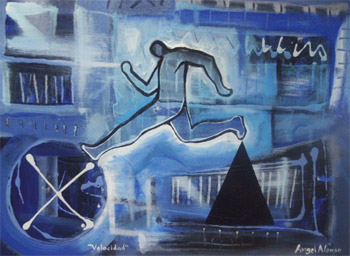
And yes, the Special Period, like all crises, turned out to be an opportunity for some. Without that crisis there wouldn’t have developed the mechanisms for selling work, not even the primitive mechanisms that exist today. Previously painters had to take their works to a commission of the “Fondo Cubano de Bienes Culturales” (the Cuban Cultural Resources Fund), whereas later it became possible to market through galleries as well as in the public arts and crafts bazaars.
HT: Is it difficult to be a painter in Cuba (keeping in mind what it takes to sell one’s works and buy materials)?
AA: Being a painter, a sculptor or whatever form of visual art that you cultivate is difficult, especially taking into account that it’s an extremely competitive career where exclusivity is what’s valued, and this isn’t only in Cuba.
I used to live in Sweden, which is a very democratic country but which had major problems when it came to helping artists, foreigners or everybody who wanted to do something, as well as with everybody who didn’t want to do anything. I can tell you that in terms of arts promotion, the same things happen there as they do in Cuba, with the difference being that here all the competitive exhibition facilities are free, while in Sweden you have to pay. And if the jury doesn’t like your work, you lose your money and they don’t let you show your creations.
Also, art materials over there are sold in specialized stores. Of course there’s much more of a selection, but things are also much more expensive, so you have to think twice before buying acrylic. Plus, there isn’t a black market or some friend who’s a carpenter who can give you some nails. There’s no cheap canvas that you can prepare yourself… You have to buy everything.
HT: You say that in Cuba the exhibition spaces are free, but I know painters who haven’t been able to exhibit in commercial galleries despite their having produced quality work and their being, for example, members of the Cuban Writers and Artists Association (UNEAC). There’s a lot of hermeticism in the system, which doesn’t allow access. I’ve heard that the mechanisms don’t have so much to do with bureaucracy as with factors of internal corruption. People talk about “fixing it” with gallery administrators so that they’ll admit your work. Otherwise, someone who doesn’t know about these “arrangements” or someone who isn’t willing to engage in them only receives smiles and evasiveness. Have you had any experiences like this?
AA: I haven’t had those types of experiences. I’ve been able to exhibit in many places in Havana when someone has been interested in my work. It doesn’t enter my mind having to pay off someone to allow me exhibition space. But I can share an anecdote that illustrates how access into the large galleries can also depend on money instead of quality:
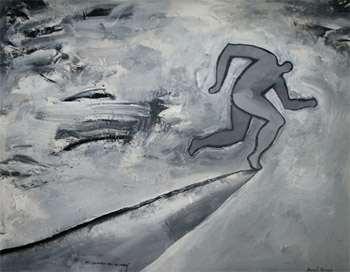
A few days ago I received an e-mail from the director of an important gallery in New York. He had seen some of my paintings on my blog and invited me to participate in a promotional program. To exhibit in that gallery can change the life of any painter, but for this you need to pay a sum that’s astronomical for any Cuban.
Returning to Cuba, I don’t doubt that some immoral administrators get paid to show people’s work. This exists, but I’m sure that if your work has quality then it’s quite possible that you’ll find many opportunities without falling into any type of corruption.
HT: Is there necessarily a need for an institution to springboard an artist, to put them in the public spotlight? Or are there other alternatives?
AA: For a long time artists dream of being independent of institutions, but a whole revolution would be needed for this, a total change in the basic functions of art. A first step for this would be the continual shrinking of ever-expanding art institutions. Really, not even we artists understand why certain paintings are in important collections or auctions, or why they’re priced so high in important galleries, or why some are considered better than other paintings that might be more interesting.
If we want to be in those spaces it’s because they guarantee us sales at good prices, endowments to carry out our work and have a better life. Within that function of launching artists, institutions are necessary but I believe there’s no need to catapult an artist toward stardom. The whole system could be made more dynamic and democratic, as was dreamt by the artists of Fluxus.
A possible alternative for this change could be the Internet, because there you can exhibit your work to thousands of people without having the approval of a curator, but nor do all of us have Internet access – so that’s not democratized either.
HT: Many people consider you a successful painter. How do you see yourself?
AA: The word “success” can be interpreted in many ways. If an artist’s work is coherent and they communicate through that work with many people, and these people go to their exhibitions, and the artist participates in some event or another of certain importance, then yes – I’d say that they’re successful. But if the image one has of success is making a lot of money and being well connected, frequently exhibiting in important galleries and selling lots of paintings, then no.
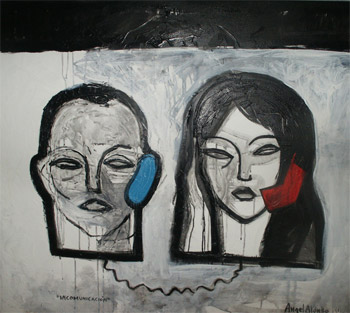
You can see that success is relative and how you pursue it can fill you with anguish. In those cases it’s better to disregard it, because you can lose your way internally. Of course I also consider it unhealthy when people shut down, when they don’t exhibit the work they do, when they refuse interviews and keep their work to themselves. To renounce success can also end up being an attitude of arrogance. I see it as very natural and healthy that the work of an artist is recognized; what’s unfortunate is that with the obsession of obtaining success many people sacrifice their dignity.
HT: That time we ran into each other on a bus, you spoke to me about how the recognition of your work had caused a radical turn in your life, that you had lost part of your peace. Is this still the case?
AA: Well, I’m trying to remember that conversation. It must have been during a period when I was traveling a lot, exhibiting a great deal, and that was starting to subject me to a good bit of stress, the sensation I was possibly reacting to. But I don’t feel that way now. I’m devoted to creating. I hardly ever travel, I’m happily married and I’m thinking about practicing Thai-Chi.
I don’t have that anxiety. I prefer to present fewer projects and to thoroughly enjoy the period of constructing the ones I have, without difficulties. It’s better to lose a couple of opportunities than to burden oneself. The secret is not to stop, but not to rush either.
HT: There are painters who are forced to hold two jobs, a commercial one that helps them to survive and another one that they really want to do – their true work. Have you ever had to divide your life like this?
AA: When I had to do something like that, I find it very painful. It’s a form of self-deception because in that case you’re dedicating time, energy and materials toward something in which you don’t engage yourself. If there are artists who can do that, I congratulate them; and if I had to do it to survive, then I’d do it too; but I prefer to do other things, like writing articles for example, or doing curatorial projects. There’s always an alternative when in addition to producing the artistic object you have other interests.
HT: How does the public generally react to your paintings? Do they understand them or are there reproaches that are not more academically complex.
AA: When there are reproaches, they involve observations from people who don’t know much about art, because my figures are not primitive; rather, they denote — through their synthesis — an academic base. It’s normal that it happens this way, since I don’t know anything about other issues then I don’t feel bothered by this. Once, during an inauguration in Sweden, a Chinese man came up to one of my paintings and was absorbed as he looked at it. I thought that he wanted to buy the painting but suddenly said to me (trying to speak in Spanish), “And this painting uh…like this?…no more?” Imagine what he would have said before a Russian supremacist paining!
HT: Aren’t the themes of loneliness and existential uncertainty among your more frequent ideas? I’m saying this because that’s what I feel with many of your images…
AA: Yes, you’re reading it well, because those are two existential aspects with which I constantly deal: loneliness and uncertainty are typical conditions of Western culture, which almost everyone is now part of on this planet. In other cultures individuality is not developed in the same manner. In Structural Anthropology Claude Levi-Strauss explained how there are tribes where if the individual is separated from the group, they go insane and perish. It was just the opposite with Robinson Crusoe, a Western example of how one can survive alone, although with the learning they’ve received from society.
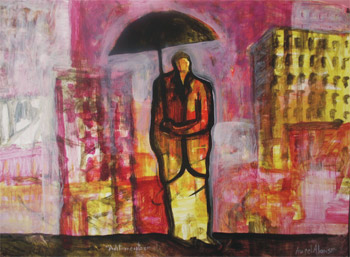
Uncertainty and anxiety in fact come from the concept of progress, from the constant transformation of the environment and the search for wealth, that’s why they are present in my painting as demonstrations of that violation that’s committed when we consider ourselves the center of the universe. Now we’re paying for that through the depletion of natural resources.
HT: Is Cuba experiencing a good time right now in terms of the visual arts?
AA: It’s a good moment from the point of view that there’s plurality. For me it’s very good that diverse languages coexist, without prejudices or tendencies, in one single art scene. This plurality destabilizes the critics since they don’t know to characterize this moment because there are very varied approaches. This is interesting, but at the same time I miss the other more explosive periods, ones of greater vitality, like the boom of the ‘80s, that was a period that Luis Camnitzer characterized as the “Cuban Renaissance.”
HT: Is it true that if an artist exhibits in an important gallery, then they themselves have to pay for the catalogs, the promotion in the press or on TV, and even the food? If this is the case, what does institutional support consist of once an artist has been officially recognized?
AA: I can give some examples of my own experience. In 2005 I exhibited at the gallery on Luz and Oficios streets, the Provincial Center of Visual Arts and Design. There they made a small color postcard-catalog of my work and they put an announcement on TV. I didn’t find anything difficult at all. However in 2007, when I put on my exhibit “Urgencias” at the MAC gallery of the MUA Foundation in Tegucigalpa, Honduras, they toasted to my work but they didn’t put together any kind of catalog – nothing. They only put up a sign that announced the show.
When I left Cuba for the first time, in 1995, I was disappointed by many exhibitions that I attended in Europe because they weren’t accompanied by catalogs. The artists almost always had to distribute little postcards — which they themselves paid for — with a picture and the address of their studio. I don’t find any differences in terms of the opportunities for material support in Cuban galleries and those in other places.
HT: Returning to the question of when I met you in the Special Period, you told me that what you painted arose from that convulsive time. What about now?
AA: I would say that though social issues are reflected in my painting, these are not an illustration of what’s happening here. I’m more interested in what’s occurring to us globally speaking. My work is a reflection of the potholes of Western culture of which we all form a part, and this is centered on a concept of the competitive and self-destructive world.
HT: What you’re saying makes me question to what extent we’re really willing to assume a way of life that’s different from what we’ve developed from competition and laxity, with the means at our disposal, with other living beings. What I’m asking is that if you benefitted from a competitive system, to what extent would you yourself be willing to give up those benefits only for a question of conscientiousness?
AA: I don’t know if I would be able to give up the benefits of the Western competitive system, because I’m not Gandhi or Jesus. I’m a simple human who before being an artist is a human being full of needs, personal ambitions and all of that. What I do indeed know is that what we can do is create alternatives for spreading ideas, ones where the role of the artist is no more important than the function of their work.
To adopt an attitude of antipathy, refusing to participate in the structures that have been created because they’re imperfect, to be declared underground…all of that I find laughable. The only thing this does is expand the culture of resentment that Harold Bloom talks about. The changes that I’m speaking to you about won’t be realized because some artists became martyrs, but by the deterioration of a system of promotion that doesn’t evolve, one that repeats itself and loses credibility.
HT: Do you really believe that the underground movement is only an attitude of antipathy, of refusing to participate in the already created structures? I don’t find it laughable that a person declares themselves as being underground because they have collided with the invalidity of structures and it’s the sole option they find. Counterculture arises as a spontaneous reaction to the stagnation of the culture itself. And in Cuba there is a major alternative movement that has in fact arisen as a response to that stagnation…
AA: I consider it laughable to declare oneself “underground” because the “underground” doesn’t exist. If it did exist we would never have news of it because it would be something underground and no one would see it. What an artist does who has never been allowed to hang their work in a gallery needs to do is change the method of promotion that they adhere to in that same competitive and discriminatory system, but raising it under other ideological interests.
This would be another equally slanted channel with the same vertical functions with regard to the myth of the artist, but this time under another varnish; let’s say, the one of the pariah artist, suffering, dying…the myth that has helped certain literature and certain cinema about the lives of great artists.
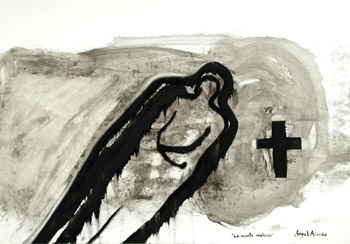
The changes in the functions of art I’m referring to have nothing to do with you exhibiting at an official event or in a house, or if you put on a show in Cuba or in France, or if your paintings come from Cuban art or Colombia art… In all cases we form part of the same obsolete and hierarchized mental structure that under different interests determines what is and what’s not a work of art (whether it’s important, momentous and/or expensive) and those are the ones who dictate since they continue being the great centers of power.
HT: Do you have approaches that are different from those that exist? A more human approach that’s not competitive or discriminatory?
AA: Yes, I think there’s a concrete approach that I can make in this sense; but before that, it’s necessary to become conscious of the unevenness of the current promotional systems. There’s a big distance between what is presumed to be the destiny or purpose of art and what really happens to it.
Many of the works whose functions are supposed make a spiritual sense remain in safe-deposit vaults where the owners don’t even look at them. They only possess them for their monetary value. There are also documentaries that criticize how paintings are sometimes bought in auctions by their same owners so that they can draw attention to those works in order to increase their value.
Although we’re caught in these mechanisms, I propose that we take concrete actions consisting of carrying out works that are not presented under the label of “ART.” It seems a paradox but there are experiences that have been carried out in this sense. I’m referring to actions that, when lacking commercial opportunities and prestigious laurels, they allow you to thoroughly feel what you’re doing and they permit the spectator or the participant to consume the artistic product without prejudices or myths.
There can even be experiences for oneself, without spectators, like that of one youth who carried out a performance that consisted of living one day without money. There doesn’t exist a documentary on this work because its recording would have implied a minimum expense, and that would have betrayed its intent. Likewise there’s the experience of Torres Llorca, when he located in the street an installation called “Con tu enemigo bajo el mismo techo” (With your enemy under the same roof), and filmed people’s reactions. Their responses were much more interesting than when the work was shown in the gallery because people in the street approached the piece without knowing that it was a work of art.
This work won’t change the current panorama, but it’s realizable and it demonstrates how the art experience works better without the art institution.
HT: As a nation, what do you think Cuba is lacking?
AA: This is a question that should be directed to a political analyst or an economist, but I won’t refuse to answer it. I can answer it with total sincerity. I’ve never asked myself about what a nation lacks, not my country or any other one. The external reality is always like it is and those who complain about whatever’s lacking are only stirring up anxiety and useless complaints.
I don’t have a very developed opinion of the nation — at least not a conscious one — or what it means for me to be Cuban. There are a couple of facts that demonstrate my psychological dependence on my context: one of them is that I gave up my permanent residency in Sweden to come live here, and the other one is that I have a European passport; my father lives in Spain, he has an empty room and if I wanted to I’d be there right now.
I think that if each one of us were to work more on our internal balance, trying to eliminate resentments, self-destructive internal dialogue, complaints and comparisons… then the external things would also be better.
Click on the thumbnails below to view all the photos in this gallery. On your PC or laptop, you can use the directional arrows on the keyboard to move within the gallery. On cell phones use the keys on the screen.
















